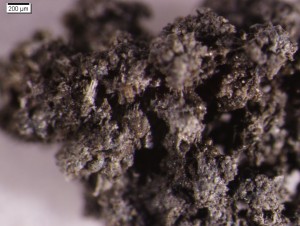The planet Mercury’s puzzlingly dark color could result from its bombardment with carbon-rich micrometeorites, reports a study in Nature Geoscience. This may explain why the Moon is lighter in color than Mercury, even though the Moon’s surface contains more darkening iron.
Observations of Mercury reveal a planet that reflects little light and also has a low surface iron content, suggesting that another material is probably responsible for its observed dark surface. Comets are rich sources of carbon and they more frequently impact planets closer to the Sun.

Hypervelocity impact-generated agglutinates effectively trap carbonaceous material, demonstrating how delivery of micrometeoritic carbon to Mercury can darken the surface of the planet. Credit: Megan Bruck Syal
Megan Bruck Syal and colleagues calculated the total mass of carbon delivered by micrometeorites, which likely originated from comets, to the surfaces of Mercury and the Moon. They estimate that about 50 times as much carbon-rich material per unit area is retained on Mercury, compared with the Moon. Impact experiments at high velocities confirm that delivery of carbon by micrometeorites can lead to a surface color similar to that of Mercury, in agreement with observations.
Citation: Megan Bruck Syal, Peter H. Schultz, Miriam A. Riner, 'Darkening of Mercury's surface by cometary carbon', March 30, 2015 Nature Geoscience DOI: 10.1038/ngeo2397